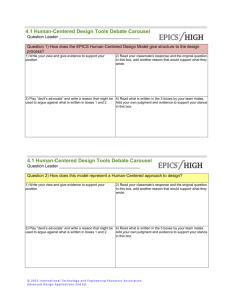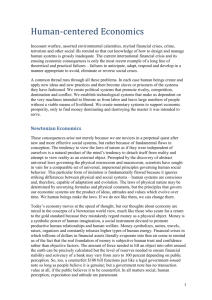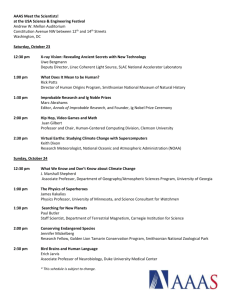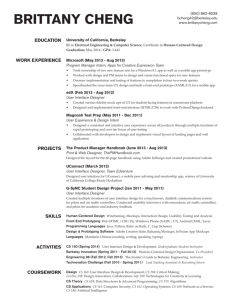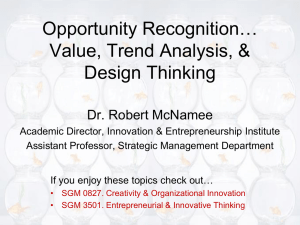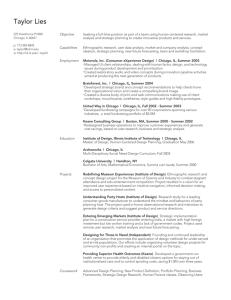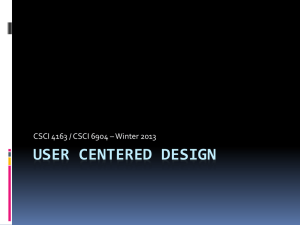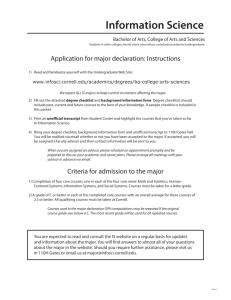A Different Role for Human-Centered Design within the Organization
advertisement
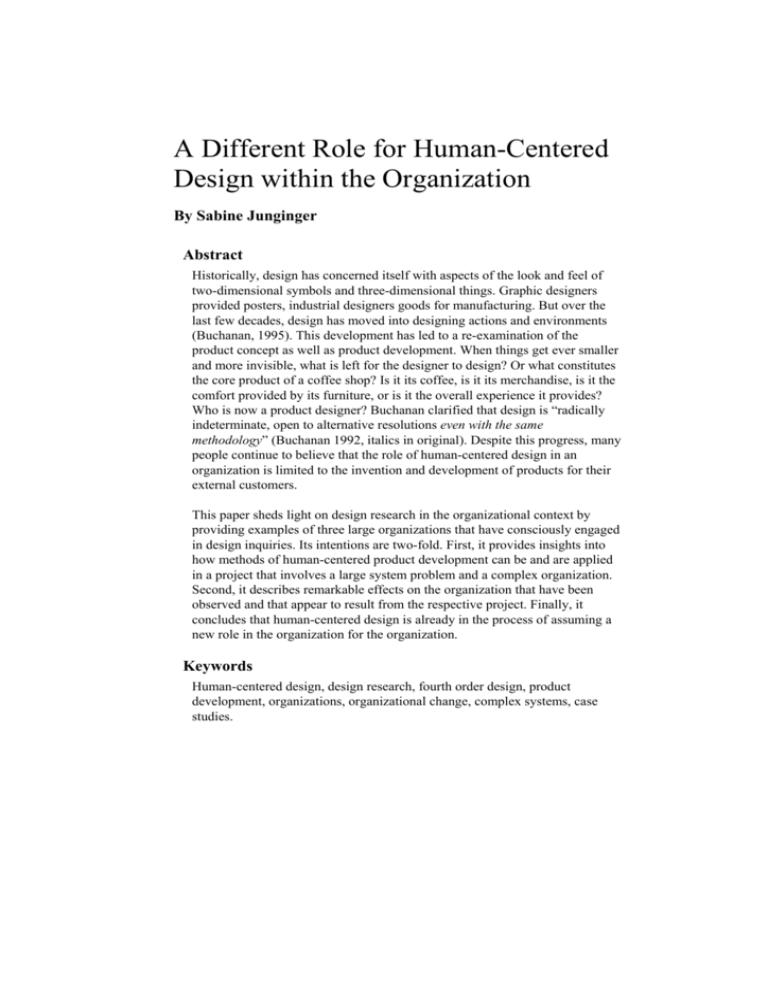
A Different Role for Human-Centered Design within the Organization By Sabine Junginger Abstract Historically, design has concerned itself with aspects of the look and feel of two-dimensional symbols and three-dimensional things. Graphic designers provided posters, industrial designers goods for manufacturing. But over the last few decades, design has moved into designing actions and environments (Buchanan, 1995). This development has led to a re-examination of the product concept as well as product development. When things get ever smaller and more invisible, what is left for the designer to design? Or what constitutes the core product of a coffee shop? Is it its coffee, is it its merchandise, is it the comfort provided by its furniture, or is it the overall experience it provides? Who is now a product designer? Buchanan clarified that design is “radically indeterminate, open to alternative resolutions even with the same methodology” (Buchanan 1992, italics in original). Despite this progress, many people continue to believe that the role of human-centered design in an organization is limited to the invention and development of products for their external customers. This paper sheds light on design research in the organizational context by providing examples of three large organizations that have consciously engaged in design inquiries. Its intentions are two-fold. First, it provides insights into how methods of human-centered product development can be and are applied in a project that involves a large system problem and a complex organization. Second, it describes remarkable effects on the organization that have been observed and that appear to result from the respective project. Finally, it concludes that human-centered design is already in the process of assuming a new role in the organization for the organization. Keywords Human-centered design, design research, fourth order design, product development, organizations, organizational change, complex systems, case studies. A Different Role for Human-Centered Design within the Organization Introduction Historically, design has concerned itself with aspects of the look and feel of two-dimensional symbols and three-dimensional things. Graphic designers provided posters, industrial designers goods for manufacturing. But over the last few decades, design has moved into designing actions and environments (Buchanan, 1995). This development has led to a re-examination of the product concept as well as product development. When things get ever smaller and more invisible, what is left for the designer to design? Or what constitutes the core product of a coffee shop? Is it its coffee, is it its merchandise, is it the comfort provided by its furniture, or is it the overall experience it provides? Who is now a product designer? Buchanan clarified that design is “radically indeterminate, open to alternative resolutions even with the same methodology” (Buchanan 1992, italics in original). Despite this progress, many people continue to believe that the role of human-centered design in an organization is limited to the invention and development of products for their external customers. This paper sheds light on design research in the organizational context by providing examples of three large organizations that have consciously engaged in design inquiries. Its intentions are two-fold. First, it provides insights into how methods of human-centered product development can be and are applied in a project that involves a large system problem and a complex organization. Second, it describes remarkable effects on the organization that have been observed and that appear to result from the respective project. Finally, it concludes that human-centered design is already in the process of assuming a new role in the organization for the organization. Design within the Organization Organizations are environments created by human beings. Organizations are also living systems. They are systems, to use Churchman’s words, “with humans in them,” unlike for example, a clock that represents a mechanical system “without a human” (Churchman, 1968). While this paper argues that design is ready to assume a new role in the organization, the role of design within the organization has already changed several times over the past 100 years. In alignment with Buchanan’s four stages of design’s general move from symbols to things to actions to environments, design’s role within organizations, too, changed with each turn. External graphic artists and illustrators were hired early on to promote manufactured products through eyecatching advertisements. Soon after mass manufacturing took off, product design emerged and big corporations established in-house design departments. Designers took on the role of adding style to the products themselves.1 Ever 1 Among others, David Gartman („Harley Earl and the Art and Color Section: The Birth of Styling at General Motors“) and Dennis Doordan („Design at CBS“) detail since, designers contribution to the organization aimed at selling more products, increase market share, and establish leadership within an industry. Design contributed at various stages in a product’s life cycle by helping to boost sales or lower its production cost2 (Porter, 1980) or by enhancing an organization’s technological advantage through product differentiation in the marketplace (Buchanan, 2003). In more recent history, designers took on a significant role in building and maintaining a brand. This is in step with Buchanan’s third phase of design that concerns itself with relationships, or interactions. Human-centered design, the task of developing products that people find useful, usable and desirable, has proven to be a crucial element in this effort. Among other products, OXO’s Good Grip™ Potato Peeler has highlighted how human-centered design can rejuvenate an organization while shaping its relationships with customers.3. These changes amount to a move from the organizational periphery towards the organizational core, or strategic apex, as Mintzberg (1983) calls it. And yet, when it comes to core organizational issues, such as changing an organization, or developing a strategy and vision for the future, organizations still overlook designers and rely on traditional business experts from marketing, accounting, and project management. A Different Role for Human-Centered Design within the Organization This is about to change as a different role for human-centered design in organizations is emerging. It is one of deep involvement of designers in organizational life per se. The signs for this trend include a recent workshop on organizational design at New York University’s Stern Business School in which no less than three presentations referred to human-centered design as a powerful force in organizational life. Case Western Reserve’s Weatherhead Business School is currently exploring the idea of “managing as designing”. Managing as designing4 emphasizes the value of designing to organizations. Strikingly, it is managers who point out that the activity of designing is relevant to businesses, not designers! Managing as designing points to the the early role of design within an organization as one of providing visual distinction to its products. Doordan, Dennis, P. 2000. Design: An Anthology. 2 Lowering the number of components that go into a product, for example, is a common way of achieving lower production cost. 3 OXO is a US manufacturer of kitchen utensils. The owner used the frustration his wife experienced with kitchen utensils as an incentive to develop a peeler that would work for her despite suffering from advanced arthritis. The traditional potato peeler is arguably useful but less usable and even less desirable. The design team added ergonomic and aesthetic considerations in addition to the functional concerns. A wider grip now makes life easier not only for arthritis sufferers or elderly hands, but offers more comfort for every user. The potato peeler turned into a bestseller, benefiting the organization in new revenue, high visibility and a new identity that centers on ergonomic and aesthetic design. The concept proved so successful that it was extended to a wide range of additional cooking utensils. OXO is now a leading manufacturer in kitchen utensils with a highly recognized Good Grip™ brand. 4 The Weatherhead School of Management at Case Western Reserve University held the first interdisciplinary conference on this theme in 2002. The conference presentations are compiled in Boland, Richard J and Fred Collopy (eds). 2004. Managing as Designing, Stanford University Press, California. parallels in the tasks and challenges managers and designers deal with on a routine basis. It is a clear departure from the traditional management view that has emphasized the role of the manager as the one of decision maker. Managing as Designing allows the organization to be viewed as a direct product of human action. This view echoes Margolin who argues that a product is “the human-made material and immaterial objects, activities and services and complex systems or environments that constitute the domain of the artificial” (Margolin, 1989). And yet, common product definitions in design continue to link a product with something “to be sold” (Ulrich and Eppinger, 1995) and as “part of a company” (Cagan and Vogel, 2002). Margolin’s definition, in contrast, allows the organization itself to become a product in its own right. Design management has broadened the scope of design within organizations and achieved that design can influence the overall strategic planning of a company’s direction. Design Management initiated the dialogue about the value of Design to businesses. It has led to designers taking on the responsibilities of project managers and to designers being included at the early stages of product conception. Without design management and its push to educate organizations about the role of the designer in new product development, interdisciplinary product development teams would still not exist. Design Management has helped to move design up the organizational ladder, away from focusing narrowly on product development aspects to influencing and guiding an organization’s overall brand strategy. Design Management plays a role in the overall strategic planning of the company’s products and it undoubtedly has an impact on the organization. Yet, this is different from applying design methods and design thinking specifically to integrating and fine-tuning the internal organization to effect organizational change. Design Management remains focused on the products developed by the organization. It does not view the organization as a product in itself and thus does not concern itself with designing the organization. The Power of User Pathways Similar to managing, organizing is often associated with decision-making. It is used to describe activities like arranging, overseeing or structuring. Yet, as Boland and Collopy (2004) point out, most managers spend a significant amount facing design problems. In similar fashion, organizing the organization, integrating and fine-tuning people, tasks and structures, is not merely a task of reshuffling the obvious. The most difficult question when it comes to organizing or re-organizing is the question for whom and for what. A professor I know invented a fabulous exercise to illustrate this problem for information designers: She provides a handful of randomly assorted tools and items, puts them in a pile in front of them with the request to organize these things in a useful fashion. Some students eagerly begin to lay out the tools in a way that makes sense to them. Soon questions arise about the purpose of the user. Should it be by function? Should it be by color? Should it be by material?5 The options seem endless and random unless some clarification on 5 The exercise has been invented by Karen Moyer, Professor of Communication Design at Carnegie Mellon, for students who study information design. the purpose of the order provides guidance. The clarification and guidance, of course, depends on those people who will use the tools. This exercise holds a lot of value for organizations. What are their organizing principles? How easy is it for someone who wants to use their services to find a path through their corporation? Buchanan (2004) suggests that user pathways are an important concept when designing large and complex systems like organizations. Providing the right information in the right form at the right time allows people to find their way through complex environments, be they unfamiliar cities, a major hospital or a government. The changing role of human-centered design within the organization is closely linked with its ability to discover user pathways, identify gaps in this path and generating new products that close these gaps for a complete, satisfying user experience. Human-Centered Design Human-centered design distinguishes itself from other product development methods by its emphasis on user research. The success of a product is ensured by actively involving the people for whom the design is intended at every stage of the development process, from ideation to the final product. Prototypes are reviewed and tested early and often. However, successful user research requires careful thought and preparation. Indeed, the development and refinement of research practices and techniques constitutes the design of research as another dimension of design activity. For example, the distinction between testing a document architecture (which is abstract and high-level) and testing an actual document prototype with detailed passages of content presents challenges to understanding precisely what kind of information is needed from users at a certain stage in the design process. Design research demands a progressive and systematic set of research activities that are appropriate to early, intermediate, and advanced phases of product development.6 Human-centered design is at the core of interaction design. Interaction design is fundamentally about how people relate to other people and how products mediate those relationships (Buchanan 2004). Accordingly, products inherently possess qualities that shape the relationships among people. When some of these qualities change, the mediated relationships can be expected to change, too. In the organizational context, interaction design offers the opportunity to design desirable relationships for people both inside and outside the organization, using product development as the vehicle to shape these relationships and ultimately the organization itself.7 Designers with a human-centered approach are equipped to look beyond the entanglement that complicates everyday operations and prevents the organization and its members from seeing the bigger picture, the purpose of the organization, to provide useful, usable, and desirable services to their customers. By introducing the user perspective to the internal organizational 6 For more details, see Bruce Hanington, “Methods in the Making: A Perspective on the State of Human Research in Design,” Design Issues 19:4 (Autumn 2003): 9. 7 Powell uses the term „social fitness“ to describe how the “appropriate form” of an organization emerges from its interactions with its constituents. Powell, Walter W, 1991, “Expanding the Scope of Institutional Analysis” in The New Institutionalism in Organizational Analysis, Powell, Walter W., DiMaggio, Paul J. (ed.), University of Chicago Press, Chicago, pp. 183-203. context, human-centered designers can help organizations to discover actual user paths they currently provide and envision possible paths that would be preferable. Because human-centered design is participatory in nature, the organization is not simply provided a solution but takes part in the process. As we shall see from the cases below, one of the strengths of human-centered design is its ability to enter a system through a small opening in the organization, providing successful products that act like milestones in the creation of a new user pathway. Unlike many other attempts at organizational transformation, human-centered design is not one-directional, not strictly bottom-up or top-down. Since customers, employees and other stakeholders actively participate in all phases of the design process, human-centered design is able to justify why a proposed solution will provide benefits to all. It appears that the “side effects” of human-centered design within the organization have profound implications for organizational learning and organizational change. Organizational change occurs when values, norms and beliefs about the purpose of the organization change. Three Examples of Human-Centered Design in the Organization There is reason to believe that organizations, especially government organizations in democratic countries, are ideal candidates to test the limits of human-centered design in the organizational context. After all, they are created by people to serve people. And yet, so many of them fall short of this goal. Operating sometimes for over more than 100 years, these organizations present viable problems of systems design. System design, or environment design, is what Buchanan identifies as the most recent development within design. Golsby-Smith (1996) refers to this as fourth-order design. In the following, three cases are presented in which an organization turned to human-centered design in an effort to effect a change in existing customer relationships. All three cases are different with different outcomes. Indeed, the first case might be considered a failure since human-centered design was not able to convince the organization to engage in serious change. The second case presents a slow progression of design within the organization. Starting with a product development project, the principles of human-centered design are beginning to be adopted in other areas of the organization. While there is yet no concrete talk about creating internal design capabilities, already a wide interest in human-centered design research methods has been expressed. Future products of Case B will be co-developed with the organization’s customers using user research as a tool. In Case C, finally, an organization has set out to integrate design thinking and design methods into its organizational structure. Taken together, these three cases begin to fill in the idea sketched out here for a different role of human-centered design within the organization: one of aiding organizations in organizing themselves around people. They provide a first glimpse at how methods of human-centered product development can be and are applied in a project that involves a large system problem and a complex organization. Human-centered design continues to be dismissed as a viable approach for organizations. As one project manager of a large and troubled intranet application argued: “We are not able to ask everyone, we would never get done and they would never agree.” This statement does not point to the impossibility of conducting user research, it merely points to the lack of understanding human-centered design in general and its methods in particular. Instead of investing in solid user research, his human services agency has been hosting a room full of IT experts from a renowned management consultancy who are struggling to make the system work. The few interviews I had with a variety of users pointed to ethical concerns and interaction design issues that were detrimental to the project, concerns that at the time escaped the management consulting team. Second, it describes remarkable effects on the organization that have been observed and that appear to result from the respective project. CASE A: Tax Forms Simplification Project Case A concerns one of the earliest attempts by human-centered designers at designing a large, complex system. 25 years ago, US Congress passed the Paper Reduction Act into law. This law required government agencies to reduce the paperwork for people using their services. The Internal Revenue Service (IRS) found itself in trouble because American taxpayers spent up to 45 hours at the time filling out complicated forms. Both visual and verbal language resembled the tax law books the IRS tax experts were most familiar with. The majority of tax filers, though, could not understand the legal terms and IRS internal code works. As a result, a high rate in erroneously filled out forms caused additional work for IRS employees. Some of the cost was obvious: additional work-hours for IRS employees and, because of erroneous reporting, a failure to collect the right amount of tax money, which resulted in lost revenue. Another cost though included increased impatience and frustration with the tax office, which manifested itself in fewer people reporting their taxes. Both the credibility of the office and its ability to generate revenue for the government were at stake. A renowned design consultancy took on the project of simplifying the tax forms. They assigned a team, made up of a graphic designer and a writer on the front of the plain language movement8, to the project. This team weeded through the existing forms, introduced basic design principles and language derived from common usage, not the tax office. They did so by including common taxpayers in the design process. They frequently tested their redesigns in the field and they finally generated new solutions for the IRS. Among them was a strong recommendation for a short tax form for standard taxpayers, a medium tax form for people with slight deviations from the majority of taxpayers, and finally a long form for the exceptional cases. In the end, the design team was able to justify their solutions with both quantitative and qualitative findings from user research. To their surprise, the IRS was satisfied with the visual and verbal upgrade of their forms but did not want to hear anything about restructuring the forms around the different kinds of users the design team had identified. Roughly ten years later, the IRS introduced a new, short tax form, the 1040EZ (EZ stands for “easy”). The original design team, while frustrated at the time, found consolation that their work was not in vein after all. Among the things 8 For more information on the ideas behind plain language movement, see Saul Carliner,’s article „Physical, Cognitive, Affective: A Three-Part Framework for Informaiton Design. Technical Communication, Fourth Quarter 2000. Also look for Karen J. Schriver’s „Ten Information Design Principles Guiding Schriver’s Revision of the 1040.“ Here she desribes the most current redesign efforts of the short IRS tax form. A link to her work can be found at: www.jsonline.com/bym/your/apr04/222255.asp. that can be learned from this case is that human-centered design within the organization must include members of this organization in the design process. The organization’s participation in the process is an indicator for the acceptance of the solution into the organization. Introducing the results of human-centered design efforts into an organization that has not managed the shift from organizational perspective to user perspective is doomed for failure. Further, the design team is in danger of ignoring key organizational aspects that can be detrimental to the sustainability of a particular design. In the IRS case, a different party won the next presidential election and provided a new commissioner who was closely linked to the tax service industry. His incentives to facilitate tax forms might not have been as high as the previous commissioner’s who did not have such links. CASE B: The DMM Transformation Project9 Case B concerns a project currently underway at the United States Postal Service (USPS). This project is framed by a congressional mandate to become more accessible and usable. Working together with a group of design researchers at the School of Design at Carnegie Mellon, the USPS is transforming one of its core document, the Domestic Mail Manual (DMM) from a book that causes intimidation and anxiety into guides that allow mailers to take appropriate action. The project, now in its third year, is nearing its completion phase. The USPS turned to design researchers because they had already attempted several rounds of redesigns, each causing new issues and never solving the underlying problem: The document was written and maintained from the point of view of the Postal Service. Even experts had a difficult time to navigate, find and apply different rules. In summary, it resembled very much the pile of tools and items in the exercise described above. The development of the project is important here, as it shows how human-centered product development can move design from the organizational periphery towards the organizational core. The DMM project began with six design students conducting a feasibility study for the document that generated a range of recommendations to make the document more usable, useful and desirable. Initial user research revealed that the USPS serves four distinct customer groups: household mailers (my grandma), small and medium business mailers (your corner store), large mailers (online businesses who make mailing part of their business) and finally, exceptional mailers (those who mail queen bees, for example). Accordingly, the DMM was scoured for information relevant to each group and when the project officially began in fall 2001, additional user research was conducted to learn as much about the different meaning of mailing. At this point, all design efforts centered on the development of a small guide for the household mailer. What appeared on the surface as document design was of tremendous organizational importance: Continued user research and workshops familiarized the core team at the USPS with human-centered design methods. USPS employees participated themselves in the research effort and actively supported the design team in the generation of solutions. In this important first phase, USPS employees provided content expertise and knowledge of 9 The author has been part of this project from Fall 2001 through Fall 2004. organizational necessities. Eventually, the tiny document was to contain all the design principles and core values that would shape the overall project. At the same time it did not touch directly on the work done in the organization since only few rules concern household mailers. This changed with the next phase, in which a document was prepared for business mailers. In line with human-centered design, the circle of participants widened. Now stakeholders from very different USPS areas became involved in the design process. Resistance to change was growing, too. But user research generated arguments from customers that together made a strong case. It is remarkable how the involvement of the USPS members changed with each phase and how the demands on the design team increased over time. Similarly to the IRS’ problem with legalistic and idiosyncratic language, mailers are still presented with what is known as “postalese”. During the last year, Carnegie Mellon’s design team has been charged with rewriting (not changing) the rules. In fact, when one of the existing rules was undergoing a change earlier this year, the design team was contacted and asked to show that the rule could be written in the style of the first document. Rulewriting happens at the core of an organization. This is just one example that shows how human-centered design is reaching beyond product design in the traditional sense. CASE C: The Australian Tax Office CASE C describes a project that is currently underway in Australia. Like Case A, it, too, centers on a national revenue service, the Australian Tax Office (ATO). A handful of individual design researchers from academia and professional practice act as design mentors. Their task is to aid the government agency to develop its own internal design capability. This is a very different concept than setting up an in-house design group. ATO’s intention is to embed design practice into their daily work. Currently, new product development is undertaken by tax office employees who have been familiarized with the principles and methods of humancentered design in what may be called crash-courses, a sequence of design conferences particularly organized for the ATO. It is significant that this government agency consciously decided to turn to design thinking and design methods to change its vision, values and relationships with their customers. Using these methods and principles, employees in the tax office invent and develop new products from a human-centered perspective. Research activities like “standing in your customers shoe” has led to a shift in the way the office views its customers. Before the design intervention, all Australian taxpayers were treated as one homogeneous group whose main goal was to avoid paying taxes. Thus the approach the office took to taxation was one of penalizing and demanding. Through user-research, they found that they actually served four different types of taxpayers. This may have been expected from any human-centered design effort. What is truly amazing though is that the organization restructured itself to support the application of design methods and design thinking. For example, ATO brought in several new people from the outside that had no previous knowledge of the “tax world”. Instead, most of these new people were experienced in facilitating meetings or showed high “people skills”. This group of outsiders is now acting as design facilitators. In this role, they uphold the principles that guide current and future services of the tax office. User researchers were brought in, mostly from industries that had advanced the field. The position of “information designer” has been created, though their current activity involves mostly the documentation of a team’s work process. As one employee at the P-Tax office said, the arm responsible for personal income taxes: “ I have seen many change programs come and go. Among them, Total Quality Management had the most significant and lasting impact. However, this is the first time we ourselves are being asked to change the way we are working.” Indeed, this seems to be the beauty of human-centered design in the organization: That it empowers employees and managers alike and that it is neither a straight top-down or bottom-up affair. Everyone participates in the development of this product called organization. Summary/Conclusion Seeing human-centered design at work in the organizational context affirms one of the claims of this paper: that the thinking and methods inherent to human-centered design have value to the organization itself. While this requires both managers and designers to rethink their concept of “product”, the examples presented here show that this process is already well underway. It started as far back as 25 years ago as Case A shows. Interestingly, the project title of each case already provides a hint of the role attributed to design. The Tax Forms Simplification Project is named after the tangible product deemed designable, the forms. It is unusual to describe the redesign of a document as a transformation. Thus, the project title for the DMM Transformation Project may be interpreted as an implicit acknowledgment of design’s bigger role. The Australian Tax Project, in contrast, provides a much larger framework for design by linking it to the activity of the organization: The Australian Taxation Project. The methods of human-centered design present valuable tools for organizations to organize around their customers. Human-centered design enables organizations to discover existing user experiences and create new preferable pathways. Human-centered design thus is not tied to the research and development department of an organization but can occur at the core of the organization. References Boland, Richard, J. and Fred Collopy. 2004. Managing as Designing (Stanford: CA, Stanford University Press). Buchanan, Richard, 1992. “Wicked Problems in Design Thinking,” Design Issues, 8, no. 2 (Spring 1992): 5-21. Buchanan, Richard, 1995. “Branzi’s Dilemma” in Design– Pleasure or Responsibility? Päivi Tahkokallio and Susan Vihma (eds.), Helsinki, Finland, University of Art and Design, Helsinki UIAH). Buchanan. Richard. 2004. “Management and Design: Interaction Pathways in Organizational Life.” In Boland, Richard J. and Fred Collopy (eds). 2004. Managing as Designing, Stanford University Press, California. Cagan, John and Craig M. Vogel. 2002. Creating Breakthrough Products, (Upper Saddle River, NJ: Prentice Hall). Carliner, Saul, 2000. “Physical, Cognitive, Affective: A Three-Part Framework for Informaiton Design”, Technical Communication, Fourth Quarter 2000, pp. 566-576. Churchman, C. West. 1968. The Systems Approach, (New York: NY, Dell Publishing Company). Doordan, Dennis P. 2000. Design History: An Anthology, (Cambridge: MA, The MIT Press). Golsby-Smith, Tony. 1996. Fourth Order Design: A Practical Perspective,” Design Issues, Volume 12, Number 1, Spring, 1996 (Cambridge: MA, MIT Press). Hanington, Bruce. 2003. “Methods in the Making: A Perspective on the State of Human Research in Design”, Design Issues 19:4 (Autumn 2003): 9. Margolin, Victor. 1995. “The Product Milieu and Social Action” in Discovering Design: Explorations in Design Studies, Buchanan R. and V. Margolin (eds.), (Chicago: IL, University of Chicago Press). Margolin, Victor. Design Discourse: History, Theory, Criticism. (Chicago: IL, University of Chicago Press). Mintzberg, Henry. 1983. Structure in Fives: Designing Effective Organizations, (Englewood Cliffs, NJ: Prentice Hall). Mintzberg, Henry. 1994. The Rise and Fall of Strategic Planning: Reconceiving Roles for Planning, Plans, Planners (New York: NY, The Free Press). Porter, Michael, E. 1980. Competitive Strategy: Techniques for Analyzing Industries and Competitors, (New York: Free Press, 1980; republished with a new introduction, 1998). Powell, Walter W, 1991, “Expanding the Scope of Institutional Analysis” in The New Institutionalism in Organizational Analysis, Powell, Walter W., DiMaggio, Paul J. (ed.), University of Chicago Press, Chicago, pp. 183-203. Powell, Walter W. and Paul DiMaggio, The New Institutionalism of Organizational Analysis, (Chicago: IL, University of Chicago Press). Ulrich, Karl, T. and Steven, D. Eppinger. 1995. Product Design and Development, McGraw-Hill/Irwin; 2nd edition (October 6, 1999). Sabine Junginger is a PhD Candidate (ABD) at the School of Design at Carnegie Mellon University in Pittsburgh. She currently lives in Atlanta and is in the process of completing her dissertation. Her work on the internal role of product development for organizations aims to broaden the role of designers and design within the organization. Upon finishing in May 2005, she hopes to be able to teach and conduct research in a university setting. Contact: Sabine Junginger PhD Candidate School of Design Carnegie Mellon University Pittsburgh/USA Sabine Junginger 982 Myrtle Street NE #2 Atlanta GA 30309 e-mail: sabine@andrew.cmu.edu phone: ++412.726.8906
